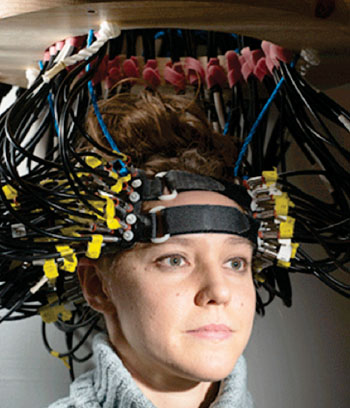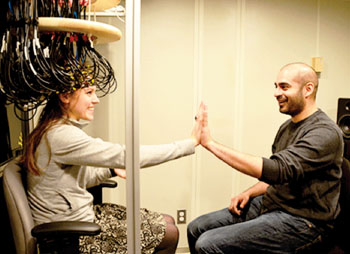Diffuse Optical Tomography Brain Scanner Designed for the OR and Bedside
By MedImaging International staff writers
Posted on 12 Jun 2014
Scientists have developed sophisticated a brain-scanning technology that tracks what is occurring in the brain by shining dozens of very small light-emitting diode (LED) lights on the head. This new neuroimaging application compares favorably to other approaches but avoids the radiation exposure and huge magnets the others require, according to new findings.Posted on 12 Jun 2014
The new optical approach to brain scanning is suited for children and for patients with electronic implants, such as pacemakers, cochlear implants and deep brain stimulators (used to treat Parkinson’s disease). The magnetic fields in magnetic resonance imaging (MRI) frequently interrupt either the function or safety of implanted electrical devices, whereas there is no interference with the optical technique.
The new technology is called diffuse optical tomography (DOT). While researchers have been developing it for more than 10 years, the technology had been limited to small regions of the brain. The new DOT device covers two-thirds of the head, and for the first time can image brain processes occurring in multiple regions and brain networks such as those involved in language processing and self-reflection (daydreaming).
The study’s findings were published online May 18, 2014, in the journal Nature Photonics. “When the neuronal activity of a region in the brain increases, highly oxygenated blood flows to the parts of the brain doing more work, and we can detect that,” said senior author Joseph Culver, PhD, associate professor of radiology at the Washington University School of Medicine in St. Louis (MO, USA). “It’s roughly akin to spotting the rush of blood to someone’s cheeks when they blush.”
The technique performs by detecting light transmitted through the head and capturing the dynamic alternations in the colors of the brain tissue. Although DOT technology now is used in research environments, it has the potential to be helpful in many medical scenarios as a surrogate for functional MRI (fMRI), the most typically used imaging technology for mapping human brain function. Furthermore, fMRI monitors activity in the brain via changes in blood flow. In addition to greatly adding to understanding of the human brain, fMRI is used to diagnose and monitor brain disease and therapy.
Another typically used imaging method for mapping brain function is positron emission tomography (PET), which involves radiation exposure. Because DOT technology does not use radiation, multiple scans performed over time could be used to monitor the progress of patients treated for brain injuries, developmental disorders such as autism, neurodegenerative disorders such as Parkinson’s, and other diseases.
Dissimilar to fMRI and PET, DOT technology is designed to be portable, so it could be used at a patient’s bedside or in the operating room. “With the new improvements in image quality, DOT is moving significantly closer to the resolution and positional accuracy of fMRI,” said first author Adam T. Eggebrecht, PhD, a postdoctoral research fellow. “That means DOT can be used as a stronger surrogate in situations where fMRI cannot be used.”
The researchers have many plans for applying DOT, including determining more about how deep brain stimulation helps Parkinson’s patients, imaging the brain during social interactions, and studying what happens to the brain during general anesthesia and when the heart is temporarily stopped during cardiac surgery. For the current study, the researchers corroborated the performance of DOT by comparing its findings to fMRI scans. Data were collected using the same study participants, and the DOT and fMRI images were aligned. They looked for Broca’s area, a key area of the frontal lobe used for language and speech production. The overlap between the brain region identified as Broca’s region by DOT data and by fMRI scans was approximately 75%.
In a second set of tests, researchers used DOT and fMRI to detect brain networks that are active when subjects are resting or daydreaming. Researchers’ interests in these networks have grown enormously over the past decade as the networks have been associated with many different facets of brain health and sickness, such as autism, schizophrenia, and Alzheimer’s disease. In these studies, the DOT data also revealed a remarkable similarity to fMRI—picking out the same cluster of three regions in both hemispheres. “With the improved image quality of the new DOT system, we are getting much closer to the accuracy of fMRI,” Dr. Culver said. “We’ve achieved a level of detail that, going forward, could make optical neuroimaging much more useful in research and the clinic.”
Whereas DOT does not allow scientists to see very deeply into the brain, researchers can obtain effective data to a depth of about 1 cm of tissue. That 1 cm contains some of the brain’s most critical areas with many higher brain functions, such as language, memory, and self-awareness, represented.
During DOT scans, the subject wears a cap composed of many light sources and sensors connected to cables. The full-scale DOT unit takes up an area a little larger than an old-type phone booth, but Dr. Culver and his colleagues have constructed prototypes of the scanner that are mounted on wheeled carts. They continue to work to make the technology more portable.
Related Links:
Washington University School of Medicine in St. Louis
















